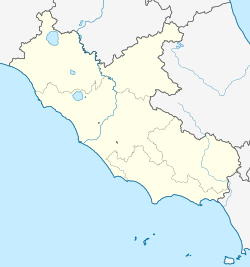
The House of Orsini is an Italian noble family that was one of the most influential princely families in medieval Italy and Renaissance Rome. Members of the Orsini family include five popes: Stephen II (752–757), Paul I (757–767), Celestine III (1191–1198), Nicholas III (1277–1280), and Benedict XIII (1724–1730). The family also included 34 cardinals, numerous condottieri, and other significant political and religious figures. The Orsini are part of the Black nobility who were Roman aristocratic families who supported the Popes in the governance of the Papal States.
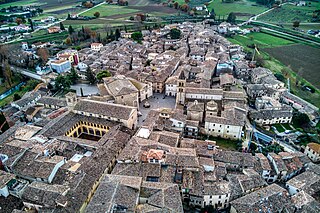
Bevagna is a town and comune in the central part of the Italian province of Perugia (Umbria), in the flood plain of the Topino river.
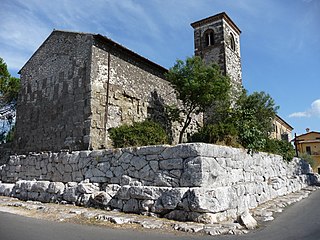
Segni is an Italian town and comune located in Lazio. The city is situated on a hilltop in the Lepini Mountains and overlooks the valley of the Sacco River.

Ardea is an ancient town and comune (municipality) in the Metropolitan City of Rome Capital, 35 kilometres south of Rome and about 4 kilometres from today's Mediterranean coast.

Vetralla is a town and comune in the province of Viterbo, in central Italy, 11 kilometres (7 mi) south of that city, located on a shoulder of Monte Fogliano.
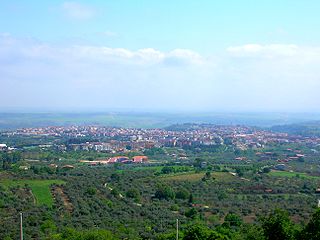
Venosa is a town and comune in the province of Potenza, in the southern Italian region of Basilicata, in the Vulture area. It is bounded by the comuni of Barile, Ginestra, Lavello, Maschito, Montemilone, Palazzo San Gervasio, Rapolla and Spinazzola. It is one of I Borghi più belli d'Italia.

Soriano nel Cimino is a town and comune in the province of Viterbo, Lazio, central Italy.

Gravina in Puglia is a town and comune of the Metropolitan City of Bari, Apulia, southern Italy.

Scheggino is a comune (municipality) in the Province of Perugia in the Italian region Umbria, located about 60 km southeast of Perugia. As of January 2020, it had a population of 464 and an area of 35.2 km2.
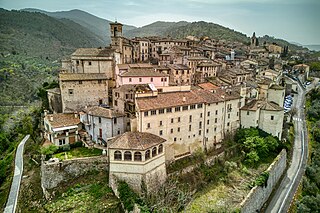
Stroncone is a comune (municipality) in the Province of Terni in the Italian region Umbria, located about 70 km southeast of Perugia and about 8 km south of Terni. It is one of I Borghi più belli d'Italia.

Capranica is a comune (municipality) in the Province of Viterbo in the Italian region Lazio, located about 55 kilometres (34 mi) northwest of GRA, 66 kilometres (41 mi) from Rome’s centre, and 24.5 kilometres (15.2 mi) southeast of Viterbo.

Sacrofano is a comune (municipality) in the Metropolitan City of Rome in the Italian region of Latium, located about 25 kilometres (16 mi) north of Rome. Located near the Monti Sabatini, at the feet of an extinct volcano, it is included in the Regional Park of Veii.

The Basilica dei Santi Bonifacio e(d) Alessio is a basilica, rectory church served by the Somaschans, and titular church for a cardinal-priest on the Aventine Hill in the third prefecture of central Rome, Italy.

San Nicola in Carcere is an ancient titular church and minor basilica in Rome near the Forum Boarium in rione Ripa. It is constructed in the remains of the three temples of the Forum Holitorium and is one of the traditional stational churches of Lent. The parish was suppressed in 1931 and it is now served by the Clerics Regular of the Mother of God from the nearby Santa Maria in Campitelli.
Marchese GerolamoTheodoli was an Italian nobleman and architect, best known for designing the Teatro Argentina in Rome.

Mario Theodoli was an Italian Catholic Cardinal.

Gesù e Maria is a Baroque church located on Via del Corso in the Rione Campo Marzio of central Rome, Italy. It faces across the street the similarly Baroque facade of San Giacomo in Augusta.

The Sacchetti family is an Italian noble family originating in Tuscany, now resident in Rome, whose earliest documented member Merlo lived during the late 10th and early 11th centuries. The name of the family is derived from one or more members known as Sacchetto. According to Ugolino di Vieri (1438–1516),"nobile Sacchetti genus est, moenia primus romanus sangius".

Giacomo Triga was an Italian painter, active in Rome, as a painter of religious subjects. He served for a time as court painter to the Marquis Gerolamo Theodoli.
Giacomo Orsini, also spelled Jacopo Orsini, was a Roman prelate, the cardinal deacon of San Giorgio in Velabro from 1371 until his death shortly after the start of the Western Schism.



